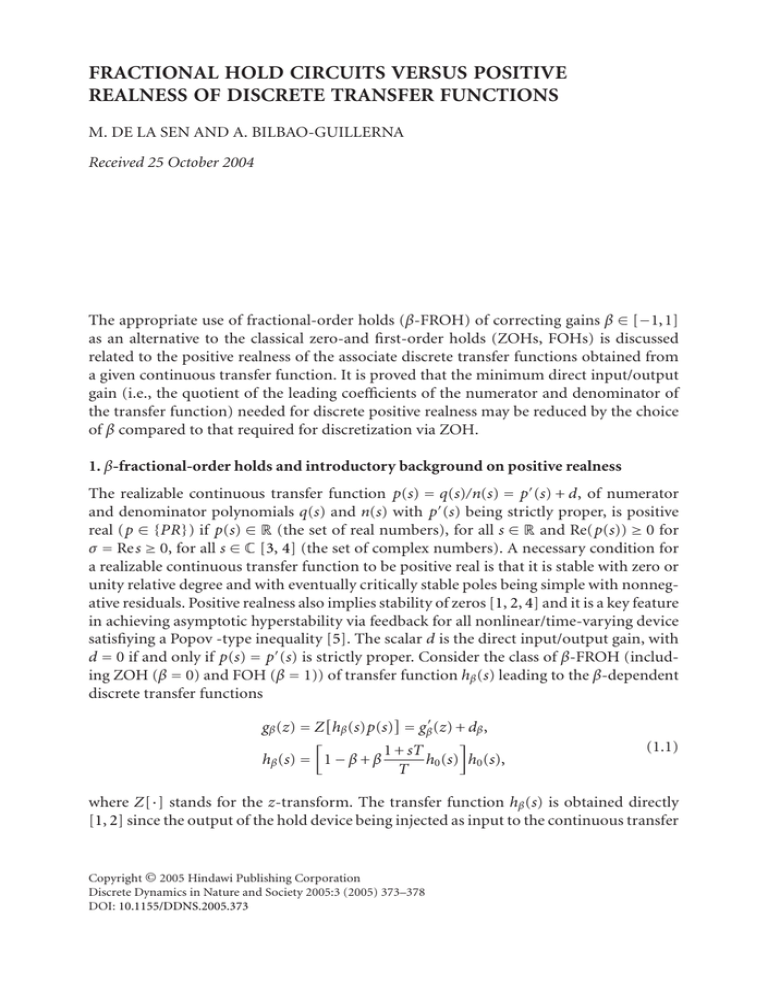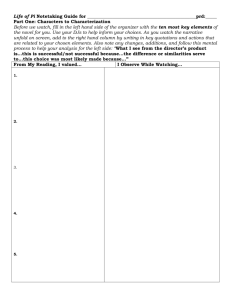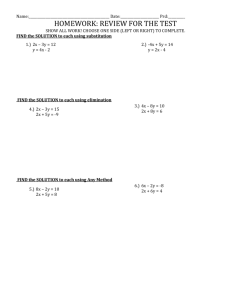FRACTIONAL HOLD CIRCUITS VERSUS POSITIVE REALNESS OF DISCRETE TRANSFER FUNCTIONS
advertisement

FRACTIONAL HOLD CIRCUITS VERSUS POSITIVE
REALNESS OF DISCRETE TRANSFER FUNCTIONS
M. DE LA SEN AND A. BILBAO-GUILLERNA
Received 25 October 2004
The appropriate use of fractional-order holds (β-FROH) of correcting gains β ∈ [−1,1]
as an alternative to the classical zero-and first-order holds (ZOHs, FOHs) is discussed
related to the positive realness of the associate discrete transfer functions obtained from
a given continuous transfer function. It is proved that the minimum direct input/output
gain (i.e., the quotient of the leading coefficients of the numerator and denominator of
the transfer function) needed for discrete positive realness may be reduced by the choice
of β compared to that required for discretization via ZOH.
1. β-fractional-order holds and introductory background on positive realness
The realizable continuous transfer function p(s) = q(s)/n(s) = p (s) + d, of numerator
and denominator polynomials q(s) and n(s) with p (s) being strictly proper, is positive
real (p ∈ {PR}) if p(s) ∈ R (the set of real numbers), for all s ∈ R and Re(p(s)) ≥ 0 for
σ = Res ≥ 0, for all s ∈ C [3, 4] (the set of complex numbers). A necessary condition for
a realizable continuous transfer function to be positive real is that it is stable with zero or
unity relative degree and with eventually critically stable poles being simple with nonnegative residuals. Positive realness also implies stability of zeros [1, 2, 4] and it is a key feature
in achieving asymptotic hyperstability via feedback for all nonlinear/time-varying device
satisfiying a Popov -type inequality [5]. The scalar d is the direct input/output gain, with
d = 0 if and only if p(s) = p (s) is strictly proper. Consider the class of β-FROH (including ZOH (β = 0) and FOH (β = 1)) of transfer function hβ (s) leading to the β-dependent
discrete transfer functions
gβ (z) = Z hβ (s)p(s) = gβ (z) + dβ ,
hβ (s) = 1 − β + β
1 + sT
h0 (s) h0 (s),
T
(1.1)
where Z[·] stands for the z-transform. The transfer function hβ (s) is obtained directly
[1, 2] since the output of the hold device being injected as input to the continuous transfer
Copyright © 2005 Hindawi Publishing Corporation
Discrete Dynamics in Nature and Society 2005:3 (2005) 373–378
DOI: 10.1155/DDNS.2005.373
374
On discrete positive realness
function is
u(t) = uk +
β
uk − uk−1 (t − kT)
T
(1.2)
for all t ∈ [kT,(k + 1)T) with uk = u(kT) for any sample-indicator integer k ≥ 0 with T
being the sampling period. Note that hβ (s) may be directly synthesized with two ZOHs
and a simple linear network. It has been proved [4] that g0 (z) is discrete positive real (g0 ∈
{PRd }) if p(s) is stable (or, in particular, positive real) and biproper (i.e., of zero relative
degree) with a sufficiently large associated direct input/output gain d0 = d ≥ dmin > 0.
/ {PRd } even if
This implies that if d = 0 (i.e., p(s) = p (s) is strictly proper), then g0 ∈
p ∈ {PR} with unity relative degree. Positive realness under discretization via β-FROH is
now discussed by first defining positive realness with prescribed margins.
Definition 1.1. It is said that gβ ∈ {PRd (ε)}, some ε ≥ 0, if Regβ (z) ≥ ε for all z ∈ UC :=
{z ∈ C : |z| = 1}.
Note that {PRd (0)} ≡ {PRd }, gβ ∈ {PRd (ε)} ⇒ gβ ∈ {PRd (ε )} for all ε ∈ [0,ε) and
gβ ∈ {PRd (ε)} for some real ε > 0 ⇒ gβ ∈ {SPRd }, that is, gβ (z) is strictly positive real
(since Minz∈UC (Regβ (z)) > 0).
2. Positive realness of gβ (z)
Direct simple calculations allow rewriting the first equation in (1.1) as
gβ (z) = 1 − βz−1 g0 (z) + dβ + βT −1 z−1 (z − 1)g01 (z)
(2.1)
if p(s) = p (s) + dβ with g01 (z) = (1 − z−1 )Z(s−2 p(s)) which implies that g0 (z) = (1 −
βz−1 )(g0 (z) + d0 ). Simple calculations with (2.1) lead to
gβ (z) = 1 + βg̃(z) g0 (z) + dβ ,
1 1 q01 (z)
−1
g̃(z) =
z T q0 (z)
(2.2)
since g01 (z)/g0 (z) = q01 (z)/((z − 1)q0 (z)) with q01 (z) and q0 (z) being the respective numerator polynomials of g01 (z) and g0 (z) since their respective denominator polynomials
n01 (z) and n0 (z) satisfy the constraint n01 (z) = (z − 1)n0 (z) from direct calculations involving z-transforms. Since p (s) is strictly proper, then gβ (z) = Z[hβ (s)p (s)] is strictly
proper of unity relative degree and order deg(n(s)) if β = 0 and (1 + deg(n(s))) if β = 0.
i, m
s ≥ m
i be such that
Let real constants mi , ms ≥ mi ; m
Re g̃(z) ∈ m
i, m
s ,
Re g̃(z)g0 (z) ∈ mi ,ms ,
∀z ∈ UC.
(2.3)
Direct calculations using the worst lower-bound minimum bound for Re(gβ (z)) from
(2.2) via (2.3) lead to
i ,
Regβ(≥0) (z) ≥ ε0 + ∆dβ + β mi + d0 + ε0 + ∆dβ m
Regβ(<0) (z) ≥ ε0 + ∆dβ − |β| ms + d0 + ε0 + ∆dβ m
s ,
(2.4)
M. de la Sen and A. Bilbao-Guillerna 375
which hold, respectively, for β ≥ 0 and for β < 0. The technical subsequent assumption is
then used.
Assumption 2.1. g0 ∈ {PRd (ε)}(⇒ g0 ∈ {PRd }) and dβ ≥ (do − ε0 ) for some real ε0 ≥ 0, all
β-FROH.
from (2.3) as m := m + (d0 +
Now, define auxiliary real constants m from m , m
( = i,s). From Assumption 2.1 and the constraints (2.4), the following result holds.
ε0 ) m
Theorem 2.2 (discrete positive realness via design of β). If Assumption 2.1 holds, then
gβ ∈ {PRd (ε)} with Regβ (z) ≥ ε for some sufficiently small ε ≥ 0 and some β-FROH, β ∈
[βmin ,βmax ] ⊆ [−1,1] if some of the subsequent items hold.
(i)
ε − ε0 − ∆dβ ≤β≤1
m
(2.5)
i
provided that
ε − ε0 ≥ ∆dβ ≥ Max − ε0, −
mi
m
i
if m
i = 0,
(2.6)
m
i = 0.
(2.7)
or
ε − ε0 ≥ ∆dβ ≥ −ε0
if mi > 0,
(ii)
ε − ε0 − ∆dβ ,1
0 ≤ β ≤ Max mi
(2.8)
provided that
−
mi
> ∆dβ ≥ ε − ε0
m
i
if m
i = 0,
(2.9)
or
∆dβ ≥ ε − ε0
if mi < 0,
m
i = 0.
(2.10)
(iii)
β < 0,
ε + ∆dβ − ε0 ,1
|β| ≤ Max m
(2.11)
s
provided that
∆dβ ≥ Max ε − ε0, −
ms
m
s
if m
s = 0,
(2.12)
m
s = 0.
(2.13)
or
∆dβ ≥ ε − ε0
if ms > 0,
376
On discrete positive realness
(iv)
ε0 + ∆dβ − ε m
1 ≥ |β| ≥ β < 0,
(2.14)
s
provided that
ε − ε0 ≥ ∆dβ ≥ Max − ε0, −
ms
m
s
if m
s = 0,
(2.15)
m
s = 0.
(2.16)
or
ε − ε0 ≥ ∆dβ ≥ −ε0
if ms < 0,
By using (2.4) with ε = ε0 , the following result stands.
Theorem 2.3 (positive realness via β-FROH by increasing/decreasing direct input/output
gains). If g0 ∈ {PRd (ε0 )} with d0 = d0 + ε0 , then gβ ∈ {PRd (ε0 )} if dβ = d0 + ∆dβ with
βmi
1
if β ∈ [0,1] with β = − ,
1 + βm
i
m
i
|β|ms
1
if β ∈ [−1,0] with |β| =
.
∆dβ ≥ Max − ε0 ,
1 − |β|m
s
m
s
∆dβ ≥ Max − ε0 , −
(2.17)
Remark 2.4. Note that the margin of positive realness, compared to that achieved with
a ZOH, is improved with smaller positive values 0 < dβ < d0 , since for positive realness
of discrete transfer functions, the relative degree is required to be zero, the direct input/
s |) provided that
output gain from Theorem 2.3 if β < 0 satisfies |β| < Min(1,1/ |m
s ) > 0. This also holds if 1 ≥ β > 1/ |m
i | with m
i < 0, |m
i | > 1, and mi < 0,
Min(ε0 , m
i |,1) if |m
i | < 1. If the usual constraint β ∈ [−1,1] is removed,
or if 0 < β ≤ Min(1/ |m
then several alternative solutions with |β| > 1 are useful for such a purpose of achieving
positive realness for 0 < dβ < d0 .
Example 2.5. Note that Theorems 2.2 and 2.3 are based on obtaining worst-case positive
lower bounds of the Re(gβ (z)), where each β-dependent right-hand side term in (2.4) is
minimized. However, it is possible to obtain refinements from positive lower bounds via
numerical evaluation of the relation
d(β) > dmin (β) := − Min gβ (z) = − Min Z hβ (s)p (s) ≥ 0.
z∈UC
z∈UC
(2.18)
M. de la Sen and A. Bilbao-Guillerna 377
2
1.8
1.6
1.4
dmin
T > 10
1.2
1
T =2
0.8
0.6
T =1
0.4
−1
−0.8 −0.6
−0.4 −0.2
0
0.2
0.4
0.6
0.8
1
0.2
0.4
0.6
0.8
1
β
Figure 2.1
0.2
0.18
T = 0.001 (dmin × 100)
0.16
0.14
dmin 0.12
0.1
0.08
T = 0.01 (dmin × 10)
0.06
0.04
−1
T = 0.1
−0.8
−0.6
−0.4 −0.2
0
β
Figure 2.2
Proceed in that way with p (s) = 1/(s + 1) ∈ {PR}. Figures 2.1 and 2.2 display the threshold dmin (β) to be used in the continuous transfer function to achieve positive realness
with a β-FROH for six distinct values of the sampling period ranging from 0.001 to
10 seconds. Note that the smaller values of such a threshold are highly dependent on
the sampling period and achieved for a range of negative values of β which improve the
threshold dmin (0) required for β = 0.
378
On discrete positive realness
References
[1]
[2]
[3]
[4]
[5]
S. Liang and M. Ishitobi, The stability properties of the zeros of sampled models for time delay
systems in fractional order hold case, Dyn. Contin. Discrete Impuls. Syst. Ser. B Appl. Algorithms 11 (2004), no. 3, 299–312.
S. Liang, M. Ishitobi, and Q. Zhu, Improvement of stability of zeros in discrete-time multivariable
systems using fractional-order hold, Internat. J. Control 76 (2003), no. 17, 1699–1711.
M. de la Sen, A method for general design of positive real functions, IEEE Trans. Circuits Systems
I Fund. Theory Appl. 45 (1998), no. 7, 764–769.
, Relationships between positive realness of continuous transfer functions and their digital
counterparts, Electron. Lett. 35 (1999), no. 16, 1298–1299.
, On the asymptotic hyperstability of dynamic systems with point delays, IEEE Trans. Circuits Systems I Fund. Theory Appl. 50 (2003), no. 11, 1486–1488.
M. de la Sen: Instituto de Investigación y Desarrollo de Procesos, Facultad de Ciencias, Universidad
del Paı́s Vasco Leioa (Bizkaia), Apartado 644 de Bilbao, 48080 Bilbao, Spain
E-mail address: wepdam@lg.ehu.es
A. Bilbao-Guillerna: Instituto de Investigación y Desarrollo de Procesos, Facultad de Ciencias,
Universidad del Paı́s Vasco Leioa (Bizkaia), Apartado 644 de Bilbao, 48080 Bilbao, Spain
E-mail address: webbigua@ehu.es






